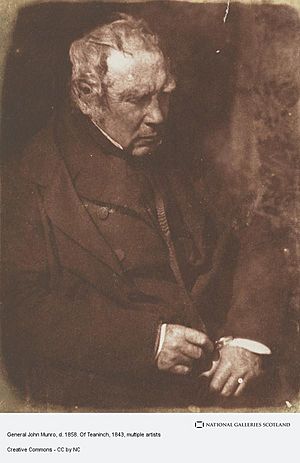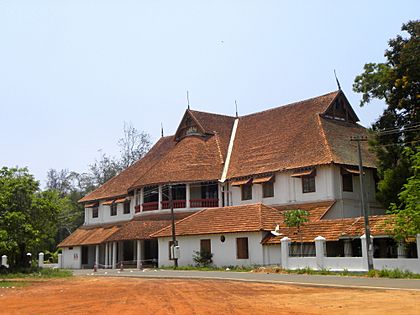John Munro, 9th of Teaninich facts for kids
Quick facts for kids
Major-General
John Munro
9th of Teaninich
|
|
|---|---|

Calotype portrait of John Munro by David Octavius Hill and Robert Adamson, 1843.
|
|
| Born | February 1775 Glasgow, Scotland, Kingdom of Great Britain |
| Died | 25 January 1858 (aged 82) |
| Buried |
Saint George CSI Church, Pallikkunnu
|
| Rank |
|
| Spouse(s) | Charlotte Blacker |
General John Munro (born February 1775 – died 25 January 1858) was a Scottish soldier and leader. He worked for the East India Company, a powerful British trading company. Munro served as a top official, called a Resident, and a chief minister, known as a Diwan. He held these important roles in the Indian states of Travancore and Cochin from 1810 to 1819.
Early Life and Family
John Munro was born in February 1775 in Glasgow, Scotland. He was the fourth son of Captain James Munro. His family, the Munros of Teaninich, were part of a Scottish Highland group called Clan Munro. Their family home was Teaninich Castle in Ross-shire.
Military Career
Joining the East India Company Army
John Munro joined the East India Company's Madras Army in April 1791. He was only 16 years old. By August 1794, he became a Lieutenant. He showed great skill in his military duties.
Key Battles and Promotions
Munro fought in the Battle of Seringapatam in 1799. Soon after, he was promoted to Captain. He became the Adjutant of his regiment. John Munro was also very good with languages. He could speak and write in French, German, Italian, Arabic, Persian, and several Indian languages.
He worked in various important roles on the Staff. He was also the private secretary and interpreter for the top commanders in India. Munro knew and regularly wrote to Colonel Arthur Wellesley, who later became the Duke of Wellington. This was during the Mahratta War. He also served alongside another famous person named Sir Thomas Munro, 1st Baronet.
Important Role as Quartermaster-General
John Munro helped stop the Vellore Mutiny. After this, he was quickly promoted to Quartermaster-General of the Madras army. He was only 27 years old at the time. This was a very high position to reach so young.
In 1807, Munro was asked to write a secret report. This report was about an allowance given to army officers, called the Tent Contract. Munro's report said that this contract made officers neglect their duties. He suggested stopping it and giving officers more pay instead. These changes caused some unhappiness among the officers. They felt their honor was questioned.
Later, Munro was arrested by the commander-in-chief, Hay Macdowall. However, the Governor, Sir George Barlow, ordered his release. These events were part of a bigger disagreement. This disagreement eventually led to the 1809 "White Mutiny" by Madras Army officers.
Soon after these events, Munro was appointed as the Resident in Travancore. His brother-in-law, Valentine Blacker, took over his old role.
Administrative Career
Reforms in Travancore and Cochin
John Munro played a big part in improving the states of Travancore and Cochin. He became the East India Company's Resident for these kingdoms in 1810. This happened after an attack by Velu Thampi Dalawa on the Company.
Colonel Munro also served as the Diwan (Prime Minister). He worked for the rulers Rani Gouri Lakshmi Bai and Rani Gouri Parvati Bai of Travancore. He also worked for Raja Kerala Varma of Cochin from 1812 to 1814. He earned the trust of the rulers and the people. He even introduced a new practice in the justice system. A Christian judge would sit alongside a Brahmin judge.

Munro encouraged these rulers to make many modern changes. As Diwan, he improved the justice system. He also increased the states' income. He worked to stop corruption and poor management. He also started the process of ending slavery. Slavery was abolished in Munroe Island in 1835. It was finally ended in Travancore by royal order in 1853 and 1855.
Social and Educational Contributions
Munro removed many taxes that affected poorer people. He was a strong Christian. He convinced the Rani of Travancore to give land, money, and timber. This was for building the Orthodox Pazhaya Seminary in Kottayam. He also asked the Church Missionary Society to send missionaries. These missionaries would help educate and train the clergy of the Malankara Church.
In 1816, the Church Missionary Society sent Benjamin Bailey, Henry Baker senior, and Joseph Fenn. They started what became CMS College Kottayam. Bailey was the first principal. With Munro's help, Bailey translated the Bible into Malayalam. Around the same time, Thomas Norton started a CMS School in Alleppy. The schools set up by these missionaries helped Travancore become a leader in primary education. Girls and boys both received schooling. This laid the groundwork for the high levels of literacy in Kerala today.
Later Life and Legacy
Retirement and Return to Scotland
John Munro went back home to Scotland in 1819. He bought Teaninich Castle from his brother Hugh. He briefly returned to India in 1823-1824. However, poor health made him retire.
He was a strong supporter of the Disruption of 1843 in the Scottish church. His portrait was used in a famous painting. This painting showed the signing of the Deed of Separation for the Free Church of Scotland. He gave land for the Free Church in Alness and became an elder there. When his brother Hugh died in 1846, John inherited the Teaninich distillery. Hugh had started this distillery in 1817.
Major-General John Munro died on 25 January 1858. He was buried in the Teaninich family vault. This vault is in Alness Old Parish Church.
Lasting Impact
Munro is remembered as one of the most brilliant and well-liked administrators. He worked in the kingdoms of Cochin and Travancore. The Travancore State Manual of 1906 praised him. It said he left a lasting name in the hearts of the people for his fairness and honesty. Even the most ordinary people in Travancore knew the name Munrole Sahib. He worked with great dedication for the good of the state.
An area of eight islands in Ashtamudi Lake in Kollam is named Munroe Island in his honor. After he died, the Travancore Government named a series of lights after him. These ‘Munro Lights’ helped guide travelers in the lakes and backwaters of the state.
Family
John Munro had four children while he was serving in Madras.
- Urban Vigors Munro (born 1801, died 1844) became the first Conservator of Forests of Travancore in 1827. He managed the state's valuable teak, cardamom, ebony, and sandalwood. His son, John Daniel Munro, later headed the Cardamom Department. He built paths to open up areas like Peermade and Munnar. This helped the tea industry start in the Kannan Devan Hills.
- James Munro (born and died 1805).
- Margaret Munro (died 1807).
- Theodosia (born 1805, died young).
John Munro married Charlotte Blacker in Madras in 1808. She was the sister of Valentine Blacker. Their children were:
- Charlotte Munro (1810 - 1875)
- James St. John Munro (born 1811) became a British Consul in Montevideo, Uruguay. He died there in 1878.
- John Munro (1820 - 1845) was a captain in the Bengal army. He was also an aide to Lord Hardinge. He was wounded in the Battle of Moodkee in December 1845 and died two days later.
- Stuart Caradoc Munro (1826 - 1911) was a tea-planter in Ceylon. He had no children.
- Maxwell William Munro (1827 - 1854) died at sea.


